Nitrogen Cycle:
Life cannot exist without nitrogen. The atmospheric air contains 77-17% nitrogen. It is an essential component of all proteins. It is required- immensely for the synthesis of amino acids, enzymes, chlorophylls,’ nucleic acid, etc.
Nitrogen gas forms approximately 4/5th of.the atmosphere and neither plants nor animals can fix N2. Plants can take nitrogen in the form of nitrates which they absorb from the soil, J and animals obtain nitrogen by eating plants.
The mechanisms which replace nitrates in the soil may be divided into 2 types—
- those which transform atmospheric nitrogen into soil nitrates (N2 fixer), and
- those which transform plant and animal protein into nitrates (decomposers).
NCERT Class 10 Science: Environment and Resource Conservation
Definition of Nitrogen cycle: The complete series of cyclical events which occur partly in the micro-organisms of the soil and partly in the tissues of higher plants and animals are collectively known as the Nitrogen cycle.
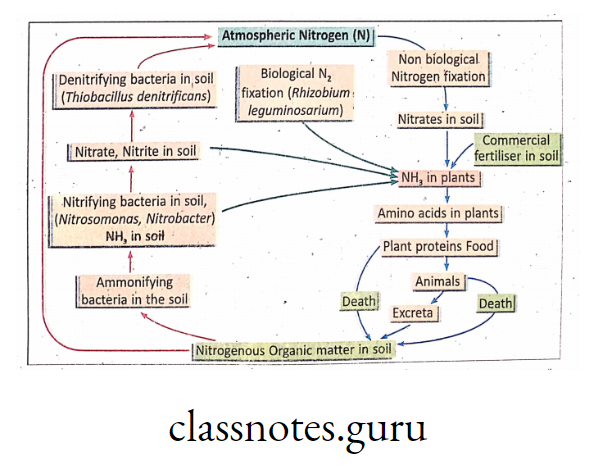
Stages of Nitrogen cycle: Nitrogen cycle consists of the various steps such as,
- Nitrogen fixation,
- Nitrogen assimilation,
- Ammonification,
- Nitrification,
- Denitrification and
- Sedimentation.
Nitrogen fixation; The process of conversion of nitrogen of atmosphere into the biologically acceptable form or nitrogenous compounds is referred to as nitrogen fixation.
Read and Learn More Class 10 Science
This process is of two types such as physico-chemical or non-biological nitrogen fixation and biological nitrogen fixation.
Physico-chemical process of nitrogen fixation—In this process the atmospheric nitrogen combines with oxygen during lightning of electrical discharges in the clouds and produces different nitrogen oxides.

These nitrogen oxides get dissolved’ in rain water and on reaching earth surface react with mineral.compounds to form nitrates and other nitrogenous compounds.

Biological nitrogen fixation—The process of conversion of molecular nitrogen of the atmosphere into nitrogenous compounds through the agency of some living organisms is called biological nitrogen fixation.
Certain bacteria, blue-green algae, leguminuous plants etc. can fix atmospheric nitrogen and are grouped as follows—
Autotrophic—
- Aerobic e.g, blue-green algae (Nostoc),
- Anaerobic e.g., Rhodospirillum, Chromatium etc.
Heterotrophic—
- Aerobic e.g., Azotobacter,
- Anaerobic e.g., Clostridium.
Symbiotic bacteria-Bacteria of this type use carbohydrate and atmospheric nitrogen to make compounds which are eventually released into the soil as nitrates.
They live inside the root cells of leguminous plants e.g., peas, beans, clover, etc. where they cause tiny swellings called root nodules.
They obtain carbohydrate from the plant cells and in return release nitrates into the plant tissues and the soil. An association of this kind in which two different organisms benefit from living together is called symbiosis, e.g., Rhizobium leguminosarum.
Many non-leguminous plants are able to fix atmospheric nitrogen. They are—Casuarina, Alnus, Podocarpus, Pinus mycorrhiza, Pavetta, Chomelia, etc.
The whole process of biological nitrogen fixation is controlled by the action of different enzymes like nitrogenase, nitrate reductase, hydroxylamine reductase and so on.
These enzymes are present in some bacteria, few blue green algae etc. but not in other plants and animals (including man). So these microbes can fix nitrogen whereas animals and plants not.
Moreover, a special Nif gene is present in N2-fixing organisms but not in other plants and animals.
The overall process of nitrogenÿ fixation may be represented as follows :

Industrial nitrogen fixation—Nitrogen fixation is essential fc>r agriculture and manufacture of fertilizer. Ammonia is a required precursor to fertilizers. The most common industrial method is the Haber process (Haber—Bosch process)

Ammonification: The process of release of ammonia and its formation to ammonium ions is known as ammonification.
The proteins of the dead plants and animals pass into the soil, that are acted upon by soil micro-organism, which decompose protein with the liberation of NH3 (ammonia).
Soil water contains a large number of hydrogen ions (H+) which chemically unite with the free ammonia to form’ ammonium ions (NH4+). The micro-organisms influencing the process are mainly, Bacillus mycoides, Bacillus ramosus and Bacillus vulgaris.
Nitrification: The process of converting ammonia to nitrate via nitrite is known as nitrification.
The ammonium ions are oxidised by a group of bacteria in the soil known as the nitrifying bacteria. Nitrosomonas converts ammonium (NH4+) ions into nitrate ions (NO2+), and Nitrobacter converts nitrite ions to nitrate ions (NO3– ).

Nitrogen assimilation: The process by which inorganic nitrogen in the form of nitrates, nitrites and ammonia are absorbed by green plants and are converted into nitrogenous organic compounds is called nitrogen assimilation.
Nitrates are converted into ammonia which combines with organic acids to form amino acids. Amino acids are used for the synthesis of protein, enzymes, nucleic acids, chlorophylls, etc.
During digestion, plant proteins are broken into amino acids which are transformed into animal proteins, nucleic acids, etc.
Denitrification: The process which involves conversion of nitrates and nitrites Into ammonia, nitrous oxide and nitrogen is called denitrification.
The process is accomplished by the denitrifying bacterias lik Bacillus denltrificans, species of Pseudomonas, Micrococcus, etc. Several autotrophs like Thiobacillus denltrificans, Thiobacillus thioparus, etc., also take part in this process.

Human activities and nitrogen cycle :
Human activities (such as use of fertilizers) greatly increase the amount of nitrogen in the environment. This excess quantity of nitrogen cycles between the living world and biosphere (soil, water and air).
This may result into some disastrous effects as follows :
Increased global concentration of nitrous oxide (N2O) may cause serious greenhouse effect (since N2O is a potent greenhouse gas).
Increased regional concentration of other nitrogen oxides like NO may result into bad air pollution that may cause bronchitis, pneumonia and other lung diseases.
Due to deposition of acids of nitrogen, substantial acidification of soil and water may cause soil pollution and water pollution respectively.
Nitrogen oxides (NOX) damages leaves of plant, growth of saplings, reduction in the rate of photosynthesis.
Excessive NOX is responsible for acid rain which is very harmful to flora and fauna.
Significance of Nitrogen cycle :
- To maintain nitrogen balance in nature.
- Nitrogen is an essential component of all protein. The cell which is the unit of living organism is made up of protein. Hence, life cannot exist without nitrogen.
- Nitrogen is the most important component of protoplasm.
- Nitrogen is th.e essential component of deoxyribonucleotide of DNA and ribonucleotide of RNA.
So, nitrogen cycle represents an excellent example—how nitrogen circulates around and through the physical and biological world, restoring (the balance of nature.
Environmental pollution
Concept of pollution. (What is pollution ?):
Environment denotes the sum total of physical and biological factors that directly influences the survival, growth, development and reproduction of organism. Environment means biosphere which includes atmosphere, hydrosphere and lithosphere.
The whole of the earth including all its living organisms and nonliving substances are together called as biosphere.
Any unfavourable change in physical, chemical and biological characteristics of surroundings (consisting of air, water and soil) due to several human activities which ’cause harmful effects on Our or other desirable species and cultural assets is known as environmental pollution.
Pollution is an undesirable change in the physicochemical and biological characteristics ofÿhe biosphere that have adverse effects over living organisms and the environment.
Types of pollution
(HGW does pullution affect our daily life ?)
Air Pollution :
Many pollutants (either natural or man made) may cause disruption of norrnal composition of atmosphere known as air pollution. There, are many causes and effects of air pollution.


Water Pollution :

Water pollution means the adverse changes in the composition and condition of water such that it becomes unsuitable for use.

Soil Pollution :
Soil pollution (land pollution) is the deterioration of the earth’s land surface, naturally or man made, which decreases the quality and productivity of plants and ground water.

Noise Pollution :
Unwanted, irregular, unpleasant and annoying sound which is caused by the vibration of matters is known as noise and the pollution caused by them is called noise pollution.


Environment, Resources, and Conservation: Class 10 Science Summary
Environment and Human Population
Problems of ever-increasing population:
(What are the problems caused by ever-increasing population ?)
Environment in the sum total of living and nonliving things which exert influence on living organisms present in a particular area. The natural surroundings of an organism, which affect its life by directly influencing its activities is called art environment.
It consists of lithosphere (soil, rocks etc.), atmosphere (air), hydrosphere (water).

Throughout the world, all the problems may be summarised as Bp’s—pollution, population and poverty. Ever increasing human population (over population) is creating lot of devastating pollution and overconsumption that can be summarised as follows :
Overexploitation and depletion of natural resources—Man is overexploiting natural resources like fossil fuel (coal and petroleum).
Deforestation and loss of ecosystem-forest trees contributes valuable quantity of oxygen to global atmosphere and thus helps to maintain O2-CO2 balance. By deforestation huge amount of forest area is decreasing causing lot of pollution hazards.
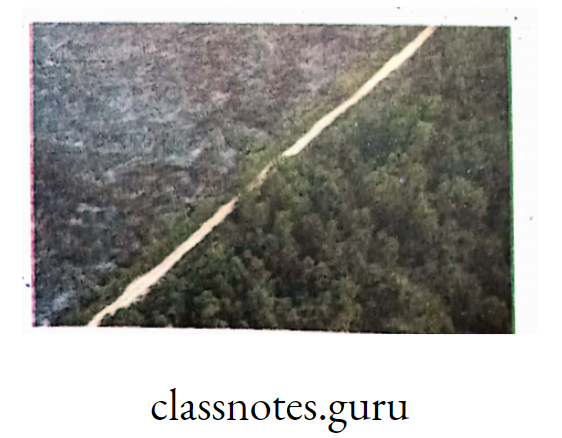
About eight million hactares of forest are lost each year.
Shrinking of agricultural land Because of extensive urbanisation, industrialisation, establishment of townships etc. agricultural land is decreasing 3/4th. of the earth is water and only 1/4th is land.
This area barren land, mountain, desert, forest, township, industry etc, So very small land area than 10%) is- available for agricultural purpose but this area is still squeezing by progressive urbanisation.
This is a big threat to global ecosystem.
Shortage of fresh water- Due to overpopulation, there is acute shortage of fresh water for drinking, regular household works and for agricuIturaL crops.

Air and water pollution—Because of overpopulation, there is parallel pollution of air, water, soil and so oh. Overexploitation of underground water by shallow and deep tubewells results into arsenic poisoning.

Changes in atmospheric condition and global warming—Due to excessive production of greenhouse gases(CO2, CH4, CFC, N2O -etc.) by industrialisation, modernisation, atmos pheric condition is gradually changingresulting into green house effect (global warming).

Destruction of wetland and its consequences—Natural or manmade aquatic habitat where water may be running (lotic) or stagnant (lentic) is called wetland. Wetlands are very useful as water reservoir, ponds for cultivation of fish etc.
They are nature’s kidney but wetlands are also threatened.
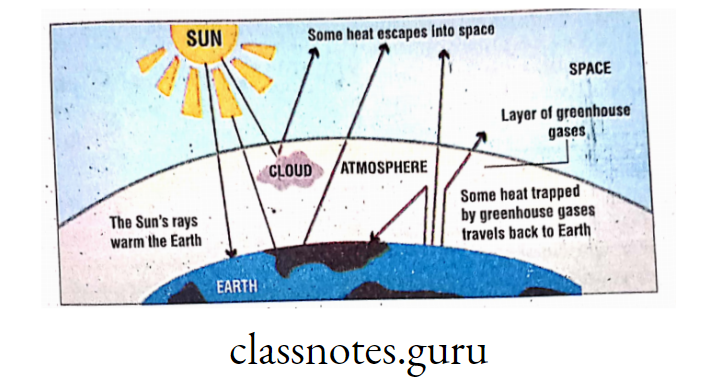
Scarcity of food-Qverpopulation leads to competition, ‘struggle for existence’ causing scarcity of food ‘and increase of price.
Environment and human health :
Various lung diseases, cancer etc. may develop due to environmental pollution and increasing population.
Lung diseases :
Asthma: This is a chronic lung disease where respiratory airways become narrow,produces extra mucus which results into difficulty in’ breathing, triggers coughing and wheezing (a whistling sound during breathing), develops chest congestion.

Some environmental triggers for asthma may be—
- Animal dander—which I is composed of tiny flecks of skin of animals (like cat, dog, rabbit, guineapig, birds etc.) with hair or feather. This may cause allergic condition to develop asthma,
- Pollen grains of plant (like parthenium).
- Dust and mould.
- Manmade chemicals like smoke of fossil fuel combustion, SO2, NO2, O3, cigarette smoke etc.
Bronchitis: It is inflammation of the membrane in the bronchus of respiratory system, which causes pain (spasm) and coughing. Bronchitis may be either acute or chronic Common causes of bronchitis may be-
- Smoking cigarettes or other forms of tobacci.
- chronic inhalation of air pollutants or fumes or dusts (from occupational hazards ) such as coal minig,grain handling ,textile industry ,farming of livestock, metal moulding or welding etc. All these may result into COPD (Chronic Obstructive Pulmonary Disease).
Cancer: Various environmental toxins or poisons may cause cancer,
- Pesticides, herbicides and radioactive substances have the potential to cause cancer,
- Smokers are at increased risk for developing lung cancer. (In fact, smokers are more susceptible to cancer).
- Tobacco chewers are at increased risk for developing oral cancer.


Tobacco smoking or chewing are actually ‘wrong life style’ that can increase the risk of cancer.
Class 10 Science: Natural Resources and Their Conservation
Biodiversity and Conservation
Biodiversity and its importance :
(How the variety of fife forms in the environment help us ?)
The term “biological diversity” was first used by Dasmann (1968). Later the term is modified into “biodiversity” by Rosen in 1985. However, the term ‘biodiversity’ is popularised by Wilson to describe combined diversity of millions of organisms on earth.
Definition: The variety of iife on earth which includes piants,- animals and other living organisms’ along with their genotype and ecological interaction are together called as biodiversity.
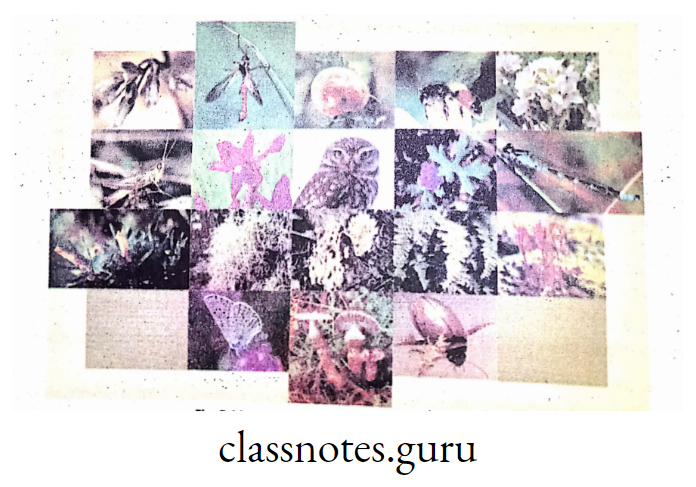
Total number of known plant and animal species on earth is approximately 15 million of which nearly 70% are animals and only 22% plants.
The species found to grow in a definite geographic area and not found elsewhere, is said to be endemic to that area. Example—one horned Rhino (Rhinoceros unicornis) is found in Jaldapara, Kaziranga forest zone but nowhere else in the world.

Importance of biodiversity :
Production of food—Different plants and animals provide us food.
Production of ‘ drugs and medidnes-Most of the plants are medicinal plants that produce drugs and medicines. Some animal products, fungus and microbes also provide us medicines.

Maintenance of ecological balance—Ecological balance is maintained by plants (producers), animals (consumers) and microbes (decomposers) through food chain, food web and energy flow.
Climate control-Climatic condition is maintained by the interaction of diverse plants,animals and microbes through biogeochemical cycles as well as conservation of biodiversity.
Economic importance—Various plants and their products
of house, household furniture, production of paper, gum, resin etc.

Various animal products like honey, beewax, dairy products,leather, silk, wool, fishery pearl etc. are very useful to us.
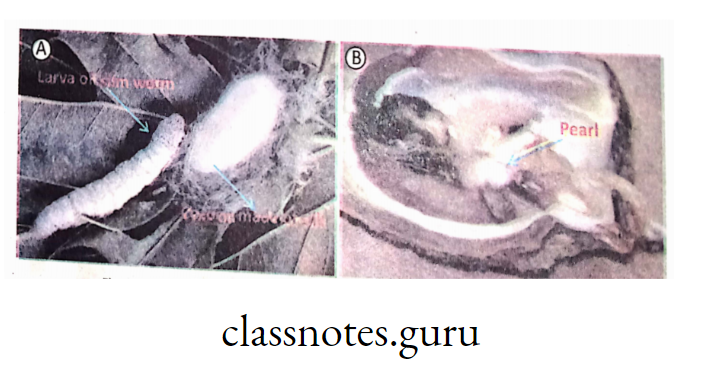
Influence on art and literature— Biodiversity helps us to study natural history.
Birdwatching, gardening, fishkeeping are due to diverse plants/flowers, animals. Biodiversity inspires musicians, painters, writers, other artists with its natural beauty. Biodiversity has intrinsic aesthetic and spiritual value.
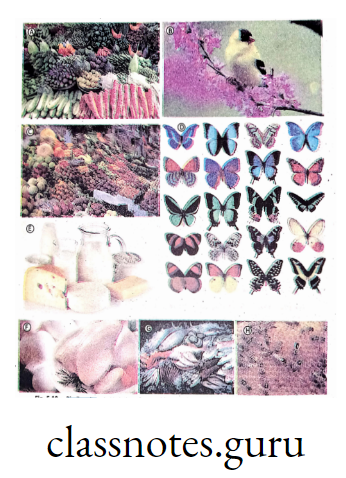
Biodiversity hotspots

Definition: The geographic areas that contain high level of species diversity but are endangered to extinction are known as biodiversity hotspots.
34 biodiversity hotspots have been identified all over the world of which four important hotspots are in India, they are Eastern Himalayas, Indo-Burma, Western Ghats and Srilanka, Sundaland.
The Eastern Himalayas—This is the region that includes Bhutan, North-Eastern India, Nepal. This is wide mountain range from where major rivers arise. This hotspot has lot of globally threatened species viz. one horned Rhinoceros, Golden langur, Wild dogs, Sloth bears, Black bear etc.

Indo-Burma—This region includes North-Eastern India, Eastern Bangladesh, Myanmar, Malayasia, Vietnam, Thailand. This region is endemic to several animals like Monkeys, Langurs,Gibbons and many birds. Many plant species are also endemic to this region. Ginger is native to this region.
The Western Ghat—These are a chain of Hills that run along the Western edge of Peninsular India upto Srilanka.
They have high rainfall, close to Indian ocean. There is moist deciduous forest as well as rain forest having lot of species diversity. Varieties of amphibians and reptiles are endemic to this area.
Sundaland—This is a biogeographical region that comprises Indonesian islands of Borneo,Sumatra, Java, Bali and Malay peninsula. (However, these area do not belong to India). This ecoregion contains a diversity of freshwater habitats including hill streams.
So many fresh water fishes are endemic here.
Loss of biodiversity ;
(What are the threats to biodiversity ?)
Primarily, because of human interference (anthropogenic), large number of plant and animal species are extinct from earth or become endangered on the verge of extinction. Some common reasons behind loss of biodiversity can be explained as follows :

Environment and Ecosystem Conservation: NCERT Class 10 Science Notes
Destruction of habitat due to change in land use pattern— This is the most important cause for loss of biodiversity. Overpopulation, urbanisation,industrialisation require huge land area. So there is destruction of natural habitat by.
filling wetlands, ploughing grasslands, cutting down trees, burning forest. So there is loss of wild natural habitat. So many plantsand animals die out. Animals requiring large area (eg. mammals and birds) are badly affected. Migrating animals are also threatened.
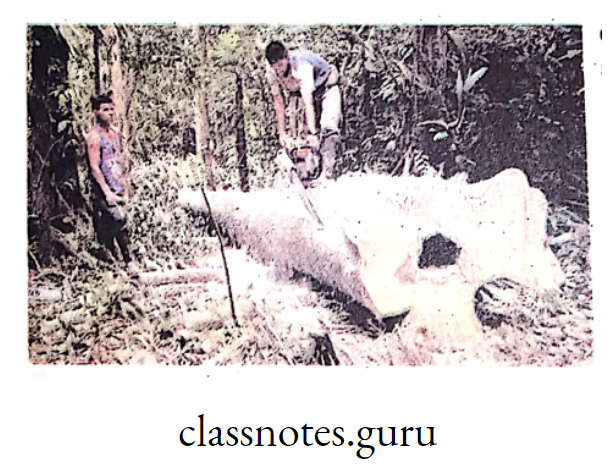
Parallelly there is also spread of agriculture—so grassland, wetland, forests are destroyed that results into extinction wi S0, there is a,so reduction in biodiversity.


Hunting and poaching—Once upon a time hunting in the forest was an example of bravery. Over the years many wild animals like tiger, cheetah, leopard, panther, deer, elephant, dolphins, whales, rhinoceros have been brutally killed.
Even today, the poachers are still killing the wild animals. Thus many animals become extinct or endangered. Presently by Government rules and laws, hunting is strictly prohibited.
Global warming and climate change—There is change of temperature, humidity, rainfall etc.—so climatic change occurs. In the history of earth, there was iceage when many organisms became extinct.
Presently, due to greenhouse effect, there is global warming when there is gross change in climate—decrease of rainfall; expansion of desert, melting of iceberg. Thus
penguins, seals, whales are also threatened.

Pollution— Excessive use of pesticide has polluted waterbodies, ground water, where many species died. Overuse of pesticide may cause biorriagnification which is more dangerous for biodiversity. There is sharp decrease of carnivorous birds like falcon, kingfisher etc.
“Run off” of fertiliser from cultivating field into nearest waterbody results into eutrophication which will cause excess demand of oxygen (BOD—Biological Oxygen Demand) which is harmful for the primary aquatic animals like
Overexploitation—Overexploitation of any species will lead to reduction in the size of population (eg. Hilsa fish and other marine fishes) so that they may become vulnerable to extinction. In last 500 years—Dodo and others have become extinct due to overexploitation by man.
Natural calamities—Cyclone, Tornado, Tsunami, volcanic eruption and other devastating natural calamities caused tremendous loss of biodiversity all over the world at different time.
Those are irrepairable, irreversible damage of biodiversity that can not be compensated.

Example—During Tsunami, coral bed at Andaman area has been badly fragmented
and swayed away at different parts of Indian Ocean.
Introduction to exotic species—Exotic species (Alien species) are those that have been imported from foreign countries of world which are growing and reproducing well in our climate.
Sometimes they become very invasive and drive away the local species to extinction.Exotic species may be harmful to both aquatic and terrestrial ecosystem.
Example—Water hyacinth (Eichhornia) was brought from Amazon Basin of South America and introduced in Indian water to resuce pollution but it has resulted into death of many indigenous aquatic plants and animals causing oss o hiodiversity.
Environmental problems of the Sundarbans
(What ails the environment of the Sundarbans ?}
Sundarban covers around Sundarbansquare kilometremeans “beautifulout of whichforest”.60% belongsThere areto BangladeshSundri trees.nd 40% in India. Sundarban is the largest mangrove wetland ecosystem in the world.
Sundarban is included under UNESCO world heritage site. It has the largest Royal Bengal Tiger reserve. It contains diverse fauna—about 35 species of reptiles, more than 270 species of birds, 42 mammals (including last population of tiger inhabiting mangroves in the world).
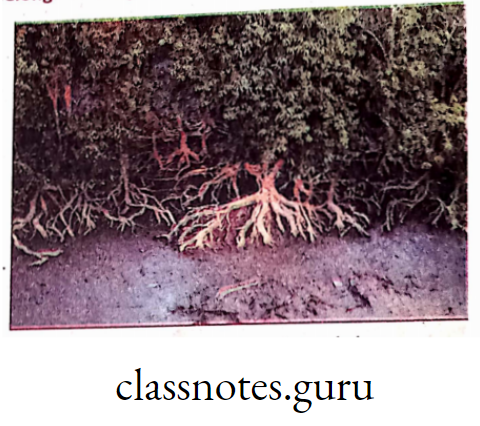
Some common local species are – tiger (Panthera tigris), Saltwater Crocodile (Crocodylus porosus), Water Monitor (Varanus sp.), Rhesus Monkey (Macaca sp.), Jackal (Canis aureus).
However, this unique coastal tropical mangrove is most threatened in the world. The threats to the mangrove ecosystem are arising partly due to natural biotic pressure from the surrounding environment and partly due to human induced (anthropogenic).The causes of threats can be outlined as follows :
Destruction of mangroves due to urbanization—Lot of forest trees are cut off for building, shops and urban development.
Agriculture—Agricultural expansion results into clearance of mangrove trees.
Eresh water crisis— Reduced flow of sweet water into Sundarban mangrove system results into fresh water crisis.
Destruction of habitat –There is continuous deforestation and destruction of habitat by cutting trees to meet the demand of small timbers and fuel wood for local consumption.
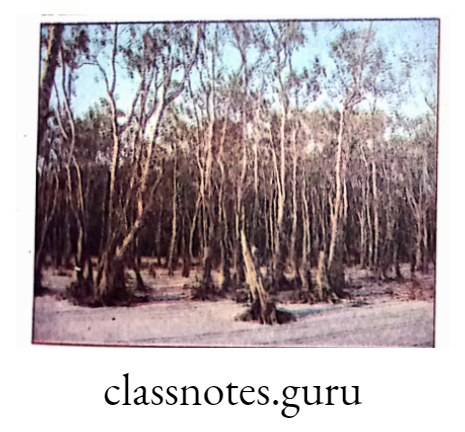
Pollution — Chemical pollution by I marine points, hydrocarbons, sewage and industrial pollution results serious threat to flora and fauna at Sundarban.
Disbalance in prey-predator number-uncontrolled collection of prawn seedlings,uncontrolled fishing, trampling of river banks by fisherman, poaching of tiger, spotted deer, wild boar, marine turtle, horse shoe crab etc. resulted problem in food chain and food web of the ecosystem.
Submergence of islands due to rising sea level —This has made worst effect on human settlement in nearby blocks. Their main livelihood—agriculture and fishing are also affected.
Climatic factors-Various natural disaster like cyclone, flood, storm etc. seriously affect this mangrove ecosystem.
Resource Conservation and Sustainable Development: Class 10 Science
Conservation of biodiversity
(What measures can be taken to conserve biodiversity ?)
Biodiversity is threatened by reduction in space, smaller and fragmented habitats, over exploitation by man, climatic change, pollution etc.
Conservation of biodiversity is a method for protection and scientific management of biodiversity to its optimum level and derive sustainable benefits for the present as well as future generations.
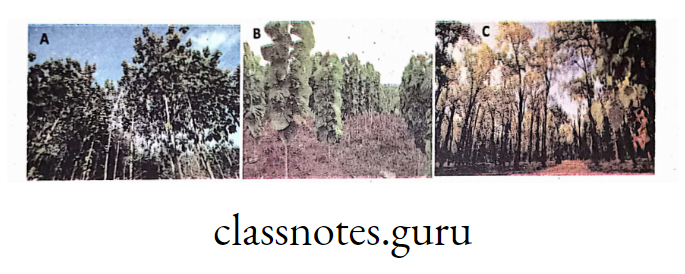
Various methods could be applied for conservation of biodiversity. These methods are divided into two major categories depending on the place of conservation. In one type life forms are conserved in their original habitat (ip-sfcu conservation) and in. another type conservation is done outside the natural habitat of the organisms (Ex-situ conservafton)

In-situ conservation: The method of conservation of biodiversity in the natural habitat of the organism is known as in-situ conservation, eg. conservation of rhinoceros in Gorumara, Jaldapara, Kaziranga forest; Royal Bengal tiger in Sundarban forest etc.
Ex-situ conservation: The method of conservation of biodiversity outside their natural habitat in the man-made system is known as e>esitu conservation, eg. conservation of different plants in Botanical garden, conservation of different animals in Zoological garden etc.
Different methods of Ex-situ conservation :
Zoological garden-
- Made by man (government) to keep endangered animals and other animals to exhibit biodiversity.
- Hunting, disturbance is strictly prohibited but visitors are allowed.
- Animals can breed and reproduce.
- The endangered animals as well as others are provided with adequate nutrition, medical care. Some research works are also done here with wild animals.

Example: Alipur Zoological Garden in Kolkata, West Bengal.

Botanical Garden—
- Endangered and rare species of plants are maintained with proper care for successful rearing.
- Also lot of different types of plants are kept for explaining biodiversity.
- Common people can visit the garden and will be aware of useful plants, eg. Acharya Jagadish Chandra Bose Indian Botanical Garden, Shibpur, Howrah, West Bengal.
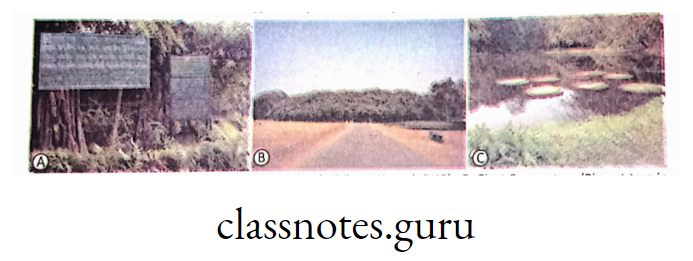
NCERT Class 10 Science Chapter: Environmental Issues and Solutions
Cryopreservation— Some plant tissues, seeds, embryos or other parts of plant may be preserved at -196″C in liquid called cryopreservation. The cryopreserved material is revived through special technique as and when required.
In order to prevent extinction, parts of endangered organisms may be cryopreserved to help in conservation.

Role of JFM -aptd -P-BR in -conserving biodiversity :
(How can common people participate in conservation efforts ?)
Joint Forest Management (JFM): This was instituted by the 1980s. It was initiated to meet the demands of the people and save forests from destruction. It involves the participation of common people in the protection and management of forests.

It was realised in 1980s by Government of India that participation of local communities around the forest area is urgently needed for conservation of forest and its natural resources. So the concept of JFM developed.
This is a joint committee of Government people and people of local communities who work together for protecting and managing forests. In return for their services to the forest, the communities get benefit of various forest”products like fruits, gum, rubber, medicine etc. and thus the forest can be conserved in a sustainable manner.
The pioneer project of JFM started in 1971 for restoration and management of degraded Sal forests (Shorea robusta) by the local inhabitants of the Arabari forest in Paschim Midnapore district in West Bengal.
JFM is the official and popular term in India for partnership in forest movement involving both the state forest departments and local JFM are communities.
The policies and objectives of in 1990. detailed Usually a in village National committee Forest Policy known of as India Forest (1988) Protection and the Committee guidelines were(FPC)prepared and the Government Forest Department enter into JFM agreement.
JFM originated accidentally at Arabari Forest Range in West Midnapore in 1971. The Major hardwood of Arabari is Sal which is commercially profitable forest crop. Ajit Kumar
Banerjee, a silviculturist, working in the Forest Department as Divisional Forest Officer (DFO), conducting trials which were constantly being disturbed by grazing animals and illegal harvesting by the local population.
The forest officials formed an adhoc Forest Protection Committee which include eleven local villagers and negotiated the terms of a contract. The contract agreement was—
- Poor villagers will get work in the forest;
- They will protect the forest resource;
- They will get 25% share of total profit;
- The vanishing Sal forest tree will be restored and preserved;
- An overall cooperation of the local people and forest official to preserve the forest resource and to prevent random deforestation.
The experiment on Arabari Sal Forest was very successful and was expanded to other parts of West Bengal and India as well. After initial success in West Bengal, followed by Haryana, JFM schemes received national inportance in the legislation in 1988.
Presently, nearly 63,000 FPCs involved in JFM of over 140,000 km2 of forested land in India.
Class 10 Science: Water, Air, and Soil Conservation Techniques
People’s Biodiversity Register (PBR): Biodiversity Management Committee (BMC) will be constructed involving local people along with government officials who will prepare People’s Biodiversity (PBR) in consultation with local people.
The register contains comprehensive information on availability and knowledge of different
local biological resources—their medicinal use,commercial use and so On as per Biodiversity Act, 2003.

This documented register is prepared to know the history of the biological resources of a particular place, changes in resource and people’s opinion about management of that resource.
A number of PBRs have been prepared in different parts of India since 1995 with the initiatives of many NGOs and educational institutions along with local communities and village councils (Panchayat).
PBR is actually a documentation of local biodiversity (flora and fauna). It includes—cultivating land, water bodies (pond, lake, canal, river etc), forest (any special variety of plant), plants (crops, vegetable, fruits medicinal plant), animals (wild animals, domestic animals, varieties of insects, birds), any other important notable feature of the place and so on.
Significance of PBR :
- PBR of a particular locality is very significant as follows :
- Identification of spots rich in local flora and fauna.
- Demarcation of areas that are biologically significant (e.g. a lake where lot of migrating birds come in every year).
- Identification of local endemic species.
- Identification of local endangered plants or animals (if at all).
- Information about local geographical history and its panoramic changes in different seasons of the year.
- Effect of natural calamity (like flood in rainy season, drought in summer) on local flora and fauna.
- Dependence of life style of local people on the local flora and fauna.
- Past history of the locality—how soil erosion has affected the area; so many flora and fauna are no more; how various types of pollution are affecting ecology of the locality.
These attempts have motivated common people to create awareness about management of natural resources. PBR will have an important role to piay in promoting conservation, sustainable use and equitable sharing of benefits of biodiversity resources in coming decade.
Some endangered species ofIndia and their conservation :
Conservation efforts of Tiger, Rhinoceros, Lion, Crocodile and Red Panda in India : (Name and place of the projects undertaken by Government of india).
For the proper conservation of all the above mentioned endangered animals, many projects have been adopted by the Government. In those projects, hunting and poaching are strictly banned.
Forest guards, pfficers, scientists are appointed to look after the wild animals.with proper care.
Wild life traditionally refers to undomesticated animal species but now it includes all plants, fungi and other organisms that grow or live wild in an area without being introduced by humans. Wildlife can be found in any ecosystem.
The four most general reasons that lead to destruction of wild life includes—
- Overkill
- Habitat destruction and fragmentation
- Impact of introduced species
- Chains of extinction (extinction of one species may cause extinction of other).
Conservation of tiger (Panthera tigris):
Tiger is the national animal of India, the most majestic cats in the world. Tiger conservation aimed to prevent the animal from becoming extinct and preserving in its natural habitat.
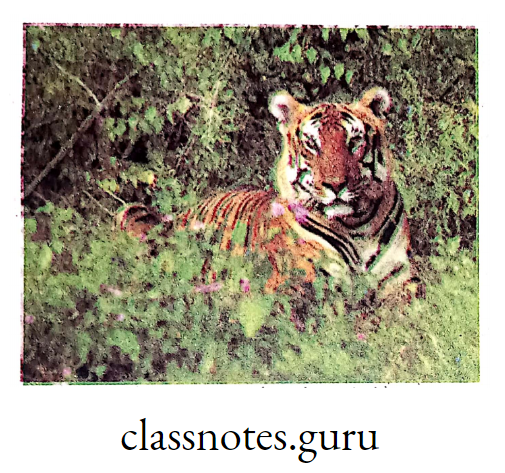
Conservation efforts: In India, Project tiger was started in 1972 to conserve tiger in-situ.(in its natural habitat). At the beginning 0f 20th century, tiger population in India was approximately 40,000 whereas in 1972, it has become only 1827.
Project undertaken: Project tiger signifies national ban on tiger hunting and poaching. Project tiger was initiated by Mrs. Indira Gandhi in 1973.
Site of project/conservation: Today, there are 27 Project Tiger wildlife Reserves in India, covering an area of 37,761 km2.
Some important sites are—
- Sundarban Tiger Reserve in West Bengal
- Bandipur Tiger Reserve in Karnataka
- Kanna Tiger Reserve in Madhya Pradesh
- Palamou Tiger Reserve in Jharkhand
Methods of conservation:
- Hunting of tiger is strictly prohibited,
- Poachers are penalised according to Indian Forest Act.
- Preservation of forest for breeding and reproduction of tiger in natural habitat (in-situ).
- Checking of deforestation and increase of afforestation,
- To deploy forest officer, forest guards etc.
Present situation/status: As a result of this program of project tiger, the population of Bengal tiger had increased from about 1200 in 1973 to an impressive 3500+ in 2007. Presently (2015) the tiger population is approximately 2226 in India.
According to report of West Bengal Forest Department, 2013, the minimum identified tiger count in Sundarbans stands at 103.
Conservation of Rhinoceros, (One horned Rhino, Rhinoceros unicornis) :
Among terrestrial land mammals In Asia, Indian Rhinoceros is second in size only to the Asian elephant They have thick grey—brown skin and a single black horn, present in both male and female.
The horn is made of keratin protein (which is present in our hair and fingernails). Rhinoceros is listed as Vulnerable on the IUCN Red list. In 2015, a total of 3555 Indian Rhinoceros are estimated to live in the wild.
They are found in Duars, Assam, North East India. Indian Rhinos were hunted relentlessly; poaching of Rhinoceros horn was the most important reason.
Conservation efforts: Indian Government has taken major steps towards conservation of Rhinoceros especially with the help of WWF (World Wild Life Fund for Nature) and other NGOs.
Project undertaken: Rhinoceros project.
Site of project/conservation :
- Jaldapara National Park in West Bengal
- Kaziranga National Park in Assam
Methods of conservation :
- Hunting and poaching strictly prohibited,
- In-situ conservation.
- Preservation of forest for natural breeding and reproduction,
- Poachers are punished according to pff Indian Forest Act.
- To deploy forest officer, forest guard etc.
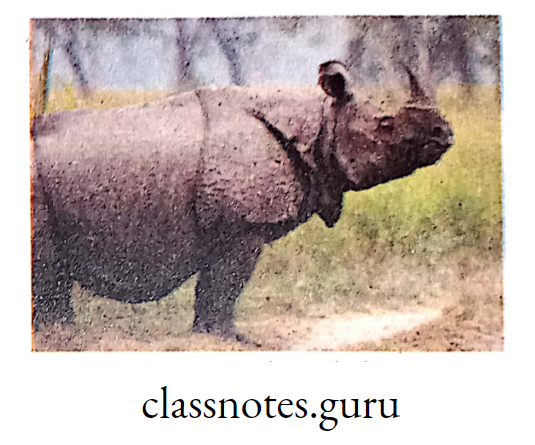
Present situation/status: In Kaziranga National Park 2048 Rhinos were estimated in 2009; in Jaldapara National Park, 108 in 2002. They must be properly preserved in order to increase their population, to protect them against extinction.
Conservation of Asiatic Lion (Panthera leo persica) :
(Also known as Indian lion or Persian lion.)
The Asiatic lion is a lion subspecies that exists as a single population in Gujrat state of India. It is listed as endangered by IUCN. Since 2010,the lion population in the Gir Forest National Park has steadily increased.

Conservation efforts: The Asiatic Lion Reintroduction Project is an initiative by j Government of India to provide safeguards to Asiatic lion from extinction in the wild by means of reintroduction.
The only single population in Gujrat faces threats of epidemics, natural disasters etc.
Project undertaken: Leo project to preserve Asiatic lion.
Environmental Conservation and Its Importance: Class 10 Science
Site of project/conservation :
- Kuno Wildlife Sanctuary in Madhya Pradesh
- Gir Forest National Park in Gujarat
Methods of conservation :
- Hunting of lion is strictly prohibited,
- Poachers are penalised according to Indian Forest Act.
- Preservation of forest for breeding and reproduction of lion in natural habitat (in-situ).
- Checking of deforestation and increase of afforestation,
- To deploy forest officer, forest guards etc.
- The project aims to establish a second independent population of Asiatic lions at the Kuno Wildlife Sanctuary in Madhya Pradesh.
Present situation/status: As per census in May, 2015, the lion population was estimated as 523 individuals of which 109 were adult males, 201 adult females and 213 cubs.
Conservation of Crocodile (Crocodylus porosus) :
Crocodile population decreased and threatened by loss of riverine habitat, depletion of fish resources and entanglement in fishing nets. They are enlisted as critically endangered on IUCN Red list.

In 1974, a survey was made by Government of India on the three species of Crocodiles present in India. They are—
- Gharia! (Gravialis gangeticus)—Found in river of North India.
- Estuarine Crocodile (Crocodylus porosus)— Found in delta region of Orissa, Sunderban of West Bengal.
- Mugger(Crocodylus palustris)—Marsh crocodile, depleted in number and very rare.
Conservation efforts: In response to declining crocodilian populations, Government of India launched a Crocodile Conservation Program in 1975.
Project undertaken: Crocodile project
Site of project/conservation :
- Bhagabatpur Crocodile Project in Sundarban, West Bengal;
- Bhitarkanika in Orissa etc.
Methods of conservation :
Collection of eggs with subsequent incubation and rearing of young until they become suitable in size to release in water—thus to boost reproductive output,
To locate, establish and manage a series of crocodile rehabilitation centres and sanctuaries in suitable habitats.
Present situation/status: 16 crocodile rehabilitation centres and 11 crocodile sanctuaries have been established. A total of 879 Gharials, 190 Estuarine Crocodiles and 493 Mugger are reared and released..
The greatest achivement is the reestablishment of viable Gharial breeding population.
Conservation of Red Panda (Ailurus fulgens) :
The red panda (also called, the lesser panda, the red bear-cat, red cat-bear) is a mammal native to eastern Himalayas. It has reddish brown fur, a long shaggy tail. It is slightly larger than a domestic cat.

It is arboreal, feeds mainly on bamboo leaves and shoots. It is active at night from dusk to dawn. It is classified “endangered’ by IUCN in 2008. They are found in Assam, Sikkim. The primary threat to red panda is uncontrolled killing or poaching, habitat destruction (due to deforestation).
Conservation efforts: India has 20 protected areas with known red panda population in Sikkim, Arunachal Pradesh. In West Bengal, there are Kanchanzonga National Park, Singalila
National Park, Namdapha National Park etc. for conservation of Red Panda.
Natural Resources and Their Conservation in Class 10 Science
Project undertaken: Red Panda Project (as mentioned above).
Site of project/conservation: In Sikkim, Arunachal Pradesh, West Bengal.
Methods of conservation :
- Hunting of Red Panda is strictly prohibited,
- Poachers are penalised according to Indian Forest Act.
- Preservation of forest for breeding and reproduction of red panda in natural habitat (in-situ).
- Checking of deforestation and increase of afforestation.
- To deploy forest officer, forest guards etc.
Present situation/status: The population of red panda has increased considerably due to development of protected areas. They breed in captivity and then can be introduced to natural habitats.
